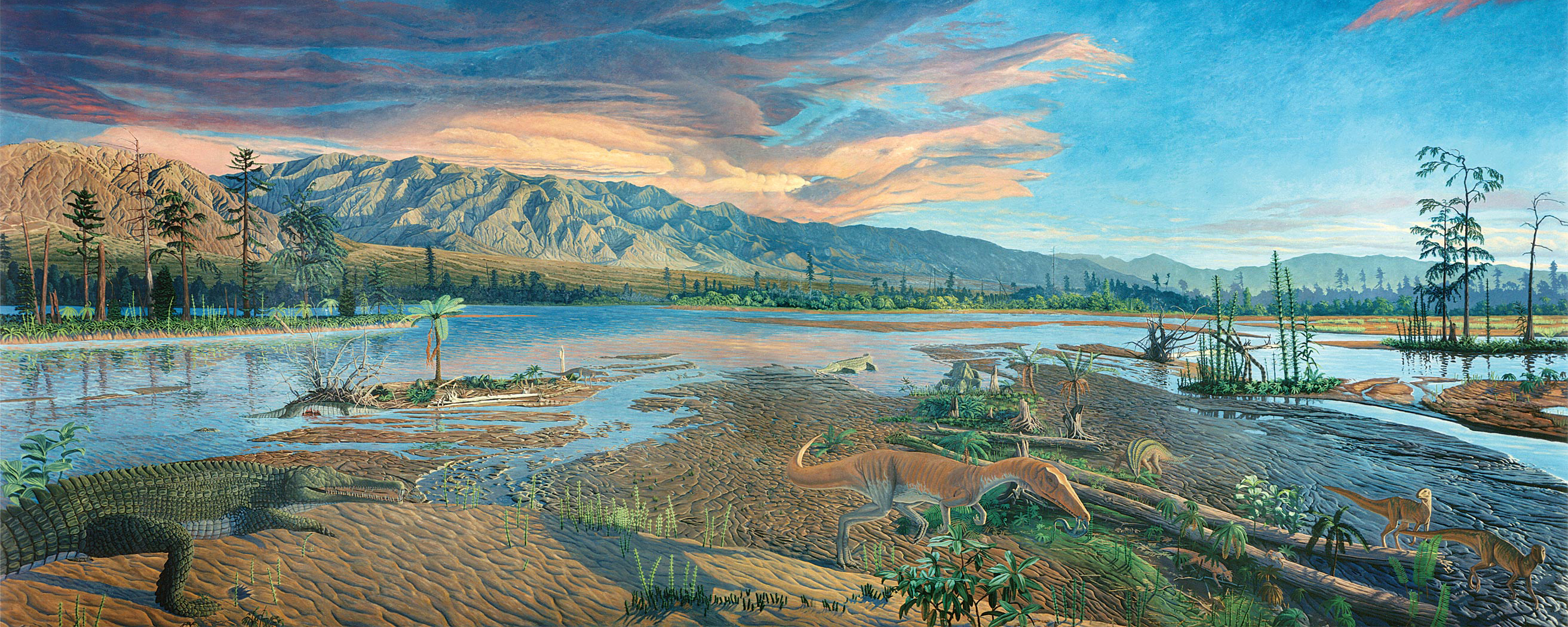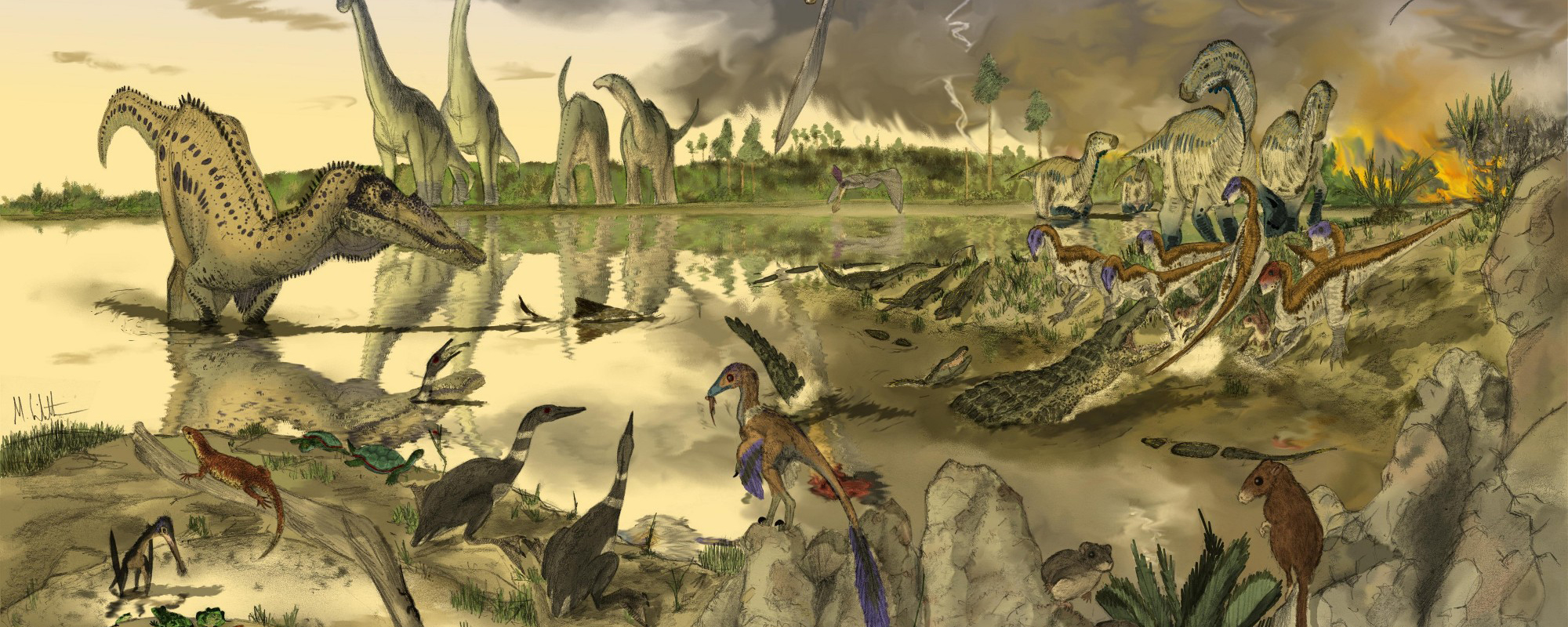


Key Points:
•The surface of the Earth is shaped by a combination of uplift (from geothermal activity), erosion (by water, wind, and weather), and gravity.
•Heat from Earth's core causes huge convection cells in the mantle; this causes the thin, semi-rigid lithospheric plates to move relative to each other.
•Plate tectonics (the action of the lithospheric plates) causes continents and oceans to move, join, or separate and causes volcanic arcs and folded mountain ranges to rise up..
•Ecology is the study of the factors which control the abundance and distribution of organisms. It examines the flow of energy in living systems, and their interactions with the environment.
•A primary aspect of ecology is trophic interactions: who eats whom. Energy enters ecosystems from sunlight captured by photosynthesis; herbivores eat the plants; carnivores eat herbivores (and other carnivores); and decomposers break down dead tissue into its component parts.
Great geological discovery of the 20th Century: Plate Tectonics
Some early indication that continents may have moved in past:
Alfred Wegener proposed model of continental drift (in 1915):
However, big flaws in continental drift:
Idea was considered unlikely by many geologists.
In 1940s through 1960s, new information. Harry Hess and colleagues discovered that fossil, radiometric, and magnetic dates showed that ocean basins were not ancient, but that they got younger closer to mid-ocean ridges, where new rock was forming. Hess called this "sea-floor spreading".
In 1960s, the models of continental drift and sea-floor spreading were combined by John Tuzo Wilson and colleagues to form plate tectonics.
Heat from Earth's core moves plates, forming mountain ranges at subduction and collision boundaries. Weather erodes uplifting mountains, wind and water and ice transports sediment to depositional environments. Over time, material becomes buried.
Plates wander over Earth's surface, so continents move from tropics to poles or back. Also, action of mid-ocean ridges causes sea levels to rise up (flooding continents) or lower (draining continents). (Current situation is very low sea level).
Big change from the 1960s-1970s model: now recognize there are LOTS of little plates (terranes) rather than just a few big plates.
Plate tectonics ultimately drives geology:
Here is an overview of the pattern of plate tectonics over the last half-billion years:
First up, some definitions:
How does energy go from the non-living environment into the living world? One major way is photosynthesis. Here is the process greatly simplified:

And here is the photosynthesis equation, simplified:
6CO2 + 6H2O + Sunlight yields C6H12O6 + 6O2
Or, in other words, photosynthesizers (plants and algae) take in water and carbon dioxide and using sunlight convert these into sugars and waste oxygen gas. Photosynthesizers are the major form of autotroph: organisms that don't eat other organisms.
In contrast, most other life forms (animals, fungi, most "protists", etc.) are heterotrophs: we get nutrients from digesting other life forms, primarily via the aerobic respiration equation:
C6H12O6 + 6O2 yields 6CO2 + 6H2O + Energy
(That is, food (glucose) plus oxygen yields waste carbon dioxide and waste water, plus energy).
In this reaction, we take in sugars and oxygen and release waste water and carbon dioxide.
So plants, algae, and other photosynthesizes are basically made up of air (and a little bit of other matter drawn from soil and/or water), while animals and other heterotrophs are made of food (ultimately plants) and air. This most important aspect of ecology is thus trophic relationships: who eats whom. These mark out relationships in a food chain of organisms that eat the organisms below them. However, since in nearly every case any species eats more than one type of food, trophic relationships are better displayed as a food web, comprised of many interlocking food chains.
The trophic level is the position an organism occupies of a food chain. Producers do not consume other animals: in terrestrial ecosystems, these are plants (which "eat" sunlight). Decomposers break down the bodies of any kind of organisms. Consumers are those that eat other organisms: 1st order consumers are herbivores (plant-eaters); 2nd order consumers eat 1st order consumers; 3rd order consumers eat 2nd and 1st order consumers; and so on, up to the apex predator (consumers that eat lower order consumers but are not typically eaten by any species but themselves).
As you move up a food chain, there is less and less energy available. Plants receive much (but by no means all) of the energy of incoming sunlight; some of that energy becomes stored as their tissues, but the rest of it is used for them to run their bodies. Herbivores consume plants, and gain some (but not all) of that stored energy, some of which they used to build their own tissues but the majority being used for their own operation (running, breathing, pumping blood, etc., etc., etc.). Predators eat the herbivores, gaining some (but not all) the stored energy in the tissues of the herbivores, using some to build their own bodies, but the rest for their operations. Thus, the amount of energy available at each trophic level becomes less and less: this is described as the energy pyramid.
Olson's Community Types: As large-bodied terrestrial vertebrates, our view of a "normal" terrestrial ecosystem is one where the food chains are pretty short: macroscopic plants to herbivores to one or maybe two levels of carnivores. This actually describes dinosaurian ecosystems pretty well, too. But in the marine realm things are different: phytoplankton through microscopic phytoplankton eaters through many levels of predators, getting successively larger.
In 1966 paleontologist E.C. Olson observed that not all fossil terrestrial ecosystems resemble the modern mammal/dinosaur style. For instance, many early terrestrial ecosystems (in the Carboniferous Period and the Early Permian Epoch, in particular) were really primarily AQUATIC ecosystems. In this, his "Type I Community", the most important producers were mostly aquatic plants, which fed various aquatic invertebrates and aquatic vertebrates of various sizes, which were fed upon by larger terrestrial and semi-aquatic vertebrates. His "Type II Community" is the one we are familiar with: macroscopic plants to medium-to-large herbivores to medium-to-large carnivores. Olson's "Type III Community" was one where the main herbivores were terrestrial invertebrates (insects, snails, etc.), followed by various levels of arthropod and small vertebrate predators, and capped by larger terrestrial vertebrates. In this Type III Community the larger number of trophic levels means that the largest animals in this food web are likely smaller than in Type I and (especially) Type II communities.
Assessing Trophic Relationships
One of the most important aspects of ecology (and paleoecology) is determining who ate whom: that is, reconstructing the food web. Sometimes there is direct trace fossil evidence: for example, this humerus of the Late Cretaceous Asian duckbilled dinosaur Saurolophus: the arrows point to bite marks generated by a tyrannosaurid (almost certainly Tarbosaurus, which is known from the same fauna).
However, sometimes we do not have such direct evidence. In these cases, we can make relatively reasonable assessments. For example, it is unlikely that small theropods habitually killed the largest herbivores in their environment (while the latter were adults, at least: babies would be fair game), and it is unlikely that there were species that were not eaten by SOMETHING.
In the case of the herbivores, however, it becomes somewhat more difficult. For one thing, it is often the case that the conditions that are best to preserve plant fossils (especially of leaves and fruits) are not good for preserving bone, and vice versa. So we often lack good knowledge of the flora that co-existed with any fauna. That said, we have the digested plant remains in coprolites as positive evidence that dinosaurs ate particular plant species (although referring a coprolite to a particular dinosaur species can be difficult.)
To Next Lecture.
To Previous Lecture.
To Lecture Schedule.
